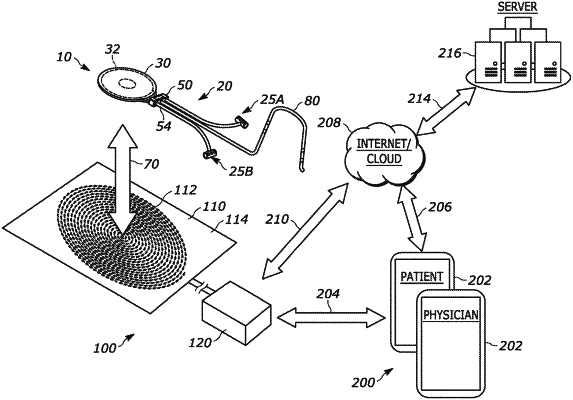| CPC A61N 1/3601 (2013.01) [A61N 1/025 (2013.01); A61N 1/0556 (2013.01); A61N 1/36135 (2013.01); A61N 1/3787 (2013.01); A61N 1/37223 (2013.01); A61N 1/37235 (2013.01); A61N 1/37288 (2013.01); G16H 20/30 (2018.01); G16H 40/67 (2018.01)] | 14 Claims |

|
1. A neuromodulation system comprising:
an antenna configured to produce an induced current in response to being disposed in an electromagnetic field;
a stimulation lead extending from a proximal end at the antenna to a free distal end, the stimulation lead having a stimulating electrical contact disposed thereon and configured to be implanted adjacent to a stimulation site between a geniohyoid muscle of a patient and a genioglossus muscle of the patient, the stimulating electrical contact being configured to deliver a stimulation signal to either a right hypoglossal nerve of the patient or a left hypoglossal nerve of the patient;
a sensing lead comprising a sensing lead body extending from a proximal end at the antenna to a free distal end, the sensing lead body comprising a proximal portion and a distal portion, the proximal portion extending between the proximal end of the sensing lead body and the distal portion and the distal portion comprising a left region, a right region, and an intermediate region therebetween, the left region having a left sensing contact disposed thereon and the right region having a right sensing contact disposed thereon, wherein the distal portion of the sensing lead body is configured to be implanted between the genioglossus muscle and the geniohyoid muscle and adjacent to a sensing site such that the left sensing contact is positioned at a left side of the genioglossus muscle and the right sensing contact is positioned at a right side of the genioglossus muscle, the left and right sensing contacts being configured to record physiological signals from the sensing site, wherein the intermediate region comprises a bend that positions the intermediate region in a different plane than the left and right regions such that when the distal portion of the sensing lead body is placed between the geniohyoid muscle and the genioglossus muscle, the intermediate region is inferior of the left and right regions and pushes the left sensing contact and the right sensing contact cranially into the genioglossus muscle;
an electronics assembly comprising electrical components to generate the stimulation signal and to control the application of the stimulation signal via the stimulating electrical contact of the stimulation lead and sensing of the physiological signals via the left and right sensing contacts;
an external controller comprising a control unit and a power transducer that supports a power transmission coil that is excitable to produce the electromagnetic field for inducing electrical current in the antenna to power the electronics assembly; and
an internal computing device comprising:
a non-transitory memory storing instructions; and
a processor to access the non-transitory memory and execute the instructions to at least:
monitor the physiological signals recorded by the left and right sensing contacts;
identify a trigger within the physiological signals, wherein the trigger is identified as a biomarker for a condition related to sleep; and
apply a rule-based classification to the trigger to determine whether one or more parameters of the stimulation signal should be altered based on the biomarker and to alter the one or more parameters of the stimulation signal in response to the biomarker.
|